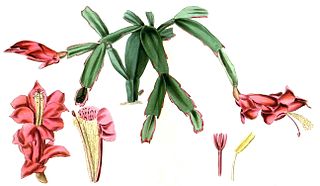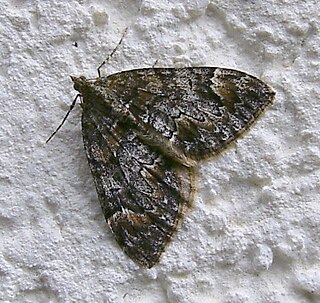
Schlumbergera truncata, the false Christmas cactus, is a species of plant in the family Cactaceae. It is endemic to a small area of the coastal mountains of south-eastern Brazil where its natural habitats are subtropical or tropical moist forests. It is the parent or one of the parents of the houseplants called Christmas cactus, Thanksgiving cactus or zygocactus, among other names.

Schlumbergera is a small genus of cacti with six to nine species found in the coastal mountains of south-eastern Brazil. These plants grow on trees or rocks in habitats that are generally shady with high humidity, and can be quite different in appearance from their desert-dwelling cousins. Most species of Schlumbergera have stems which resemble leaf-like pads joined one to the other and flowers which appear from areoles at the joints and tips of the stems. Two species have cylindrical stems more similar to other cacti.

Haworthia is a large genus of small succulent plants endemic to Southern Africa (Mozambique, Namibia, Lesotho, Eswatini and South Africa).

Nepenthes truncata is a tropical pitcher plant endemic to the Philippines. It is known from the islands of Dinagat, Leyte, and Mindanao. The species grows at an elevation of 0–1500 m above sea level. Nepenthes truncata is characterised by its heart-shaped (truncate) leaves and very large pitchers, which can reach up to 40 cm in height.
Nepenthes × truncalata is a natural hybrid involving N. alata and N. truncata. Like its two parent species, it is endemic to the Philippines, but limited in distribution by the natural range of N. truncata on Mindanao.

Nothofagus truncata, or hard beech, is a species of tree endemic to New Zealand. Its common name derives from the fact that the timber has a high silica content, making it tough and difficult to saw. Hard beech is a tree up to 30m tall occurring in lowland and lower montane forest from latitude 35°S to 42°30'S, that is, from the north of the North Island southwards to Marlborough and south Westland in the South Island. In Taranaki it forms almost pure stands on the rugged sandstone country there and is partially deciduous, dropping many of its leaves at the end of the winter. N. truncata became known as Fuscospora truncata after 2013 in New Zealand.

Strumaria is a genus of African plants in Amaryllis family, subfamily Amaryllidoideae. The genus is known in nature only from South Africa, Lesotho and Namibia. Almost all species flower in the autumn and are cultivated as ornamental bulbous plants.

Acacia truncata, commonly known as the angle leaved wattle or west coast wattle, is a coastal shrub in the family Fabaceae, with a native distribution along the southwest coast of Western Australia. A specimen of this wattle was part of an early European botanical collection, perhaps the first from Australia.

Mya truncata, common name the blunt gaper or truncate softshell, is a species of edible saltwater clam, a marine bivalve mollusk in the family Myidae.

Anthephora is a genus of plants in the grass family, native to southwest Asia, Africa, the Americas, and various islands.
Xylothamia, the desert goldenrods, is a genus of flowering plants in the family Asteraceae. Until 2003, it was held to contain nine species of shrubs native to deserts of Mexico and the southwestern United States. However, it seems to contain at least two groups. Four species are related to Gundlachia and may be moved to that genus. Plants of the World Online class it as a synonym of Gundlachia. The relationships of the other five species is not quite as clear. All nine species do belong in the subtribe Solidagininae.

Telopea truncata, commonly known as the Tasmanian waratah, is a plant in the family Proteaceae. It is endemic to Tasmania where it is found on moist acidic soils at altitudes of 600 to 1200 m (2000–4000 ft). Telopea truncata is a component of alpine eucalypt forest, rainforest and scrub communities. It grows as a multistemmed shrub to a height of 3 metres (10 ft), or occasionally as a small tree to 10 m (35 ft) high, with red flower heads, known as inflorescences, appearing over the Tasmanian summer and bearing 10 to 35 individual flowers. Yellow-flowered forms are occasionally seen, but do not form a population distinct from the rest of the species.
Josemania truncata is a species of flowering plant in the family Bromeliaceae, native to Colombia and Ecuador. It was first described by Lyman Bradford Smith in 1954 as Tillandsia truncata. Plants of the World Online sinks the genus Josemania into Cipuropsis, treating this species as Cipuropsis truncata.

Dysstroma citrata, the dark marbled carpet or northern marbled carpet, is a moth of the family Geometridae. The species was first described by Carl Linnaeus in 1761. It is found across the Holarctic ecozone and has been reported from India.

Cyanea truncata is a rare species of flowering plant in the bellflower family known by the common name Punaluu cyanea. It is endemic to the islands of Oahu and Molokai in Hawaii, but it is now critically endangered. It exists in cultivation and some individuals have been planted in appropriate habitat. It is a federally listed endangered species of the United States. Like other Cyanea it is known as haha in Hawaiian.

Haworthia truncata, locally known as horse's teeth, is a species of succulent plant in the genus Haworthia. It is found in the Little Karoo region, in the far east of the Western Cape Province, South Africa.

Nepenthes robcantleyi, or Robert Cantley's pitcher plant, is a tropical pitcher plant endemic to the Philippine island of Mindanao. It is closely allied to N. truncata and was once considered a dark, highland form of this species. Nepenthes veitchii from Borneo is also thought to be a close relative.
Nepenthes nebularum is a tropical pitcher plant native to southeastern Mindanao in the Philippines. The species was described by Geoff Mansell, owner of Exotica Plants, and Filipino botanist Wally Suarez. It has so far been recorded with certainty from only two mountains (Mount Hafas & undisclosed location, where it grows in submontane mossy forest at an altitude of up to 1800 m above sea level. It has been found in close proximity to N. copelandii, N. truncata, and a taxon matching the description of N. cornuta.

Strumaria truncata is a species of flowering plant in the family Amaryllidaceae, native to the Cape Provinces of South Africa. It is widely distributed in the northwest of the Cape Provinces, and the most common of the Strumaria species found there. It forms small clumps of bulbs which produce twisted leaves. Its flowers, which are pendulous, vary in colour from white to deep pink. The pink forms were once treated as a separate species, Strumaria rubella, and have also been called var. rubella. The species was first described by Nikolaus Joseph von Jacquin in 1792.
Leucocoprinus truncatus is a species of mushroom producing fungus in the family Agaricaceae.














